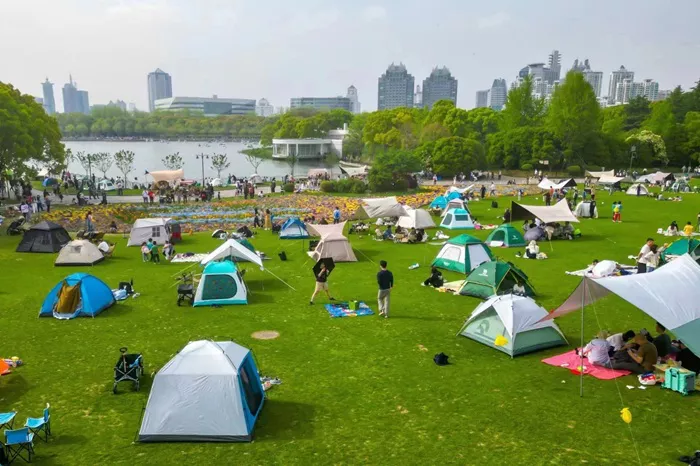Camping has exploded in popularity. You’ve probably noticed it’s harder than ever to book a campsite. What used to be a simple weekend plan now requires military-level strategy. Let me explain why this is happening.
Outdoor recreation participation jumped 6.9% in 2022 alone. More than 50 million Americans went camping that year. The numbers keep growing each season. This surge didn’t happen overnight – several factors combined to create the perfect storm.
First, the pandemic changed how people vacation. When international travel shut down, Americans rediscovered their own backyard. Camping offered the perfect socially-distanced escape. Many first-timers tried it and loved it. Now they’re hooked.
Second, social media fuels the trend. Instagram and TikTok overflow with stunning campsite photos. #VanLife has over 13 million posts. These romanticized views make everyone want to experience nature – preferably while getting the perfect sunset shot.
The Supply and Demand Problem
Not Enough Campsites for Everyone
While demand skyrocketed, supply barely changed. The U.S. has about 13,000 public campgrounds. That sounds like a lot until you divide it by 50 million campers. Popular parks like Yosemite receive reservation requests within minutes of opening.
Private campgrounds can’t keep up either. KOA (Kampgrounds of America) reports 93% occupancy rates during peak seasons. Their 500+ locations across North America stay packed.
Why Building New Campgrounds Takes Time
Creating new campgrounds isn’t simple. It involves:
- Environmental impact studies (often taking years)
- Infrastructure development (roads, utilities, facilities)
- Government approvals and permits
- Community negotiations
National parks face particular challenges. They must balance accessibility with conservation. Adding too many campsites could damage the very nature people come to experience.
The Reservation Hustle
How Booking Systems Changed the Game
Gone are the days of first-come, first-served camping. Online reservation systems now dominate:
- Recreation.gov handles federal lands
- ReserveAmerica manages state parks
- Private sites use various platforms
These systems created both convenience and chaos. Campsites open for booking 6-12 months in advance. Serious campers set calendar reminders and pounce immediately.
The Rise of the Professional Camper
A new breed of camping enthusiasts emerged:
- They study release dates like stock traders
- Use multiple devices to increase chances
- Book prime dates immediately, sometimes reselling spots
- Share tips in online forums and groups
Some even use bots to snag reservations faster than humans can click. This makes scoring a weekend spot feel like winning the lottery.
Economic Factors Driving the Trend
Camping as Affordable Vacation
With inflation squeezing budgets, camping offers relative affordability:
- Average hotel night: $150+
- Campsite night: 20−50
- No restaurant costs if cooking at site
- Free activities like hiking included
Families find they can vacation for a fraction of traditional trips. Even adding gear costs, camping saves money over time.
The Gear Effect
Outdoor retailers report record sales:
- REI saw 36% growth in camping gear sales
- Coleman’s sales doubled during pandemic peaks
- Walmart expanded camping sections significantly
More gear means more people equipped to camp. Those $400 tents aren’t sitting in garages – they’re getting used.
Demographic Shifts in Camping
Millennials and Gen Z Embrace the Outdoors
Younger generations drive much of the growth:
- 61% of new campers are millennials
- Gen Z shows even stronger interest in outdoor activities
- They prioritize experiences over possessions
- Social media plays huge role in their choices
These digital natives surprisingly crave analog experiences. After staring at screens all week, sleeping under stars offers perfect balance.
The Rise of “Glamping”
Not everyone wants rough camping. Enter glamorous camping:
- Safari tents with real beds
- Yurts with electricity
- Treehouses with wifi
- Airstream rentals with AC
These upscale options attract those who want nature…with comforts. They book just as fast as traditional sites, often at premium prices.
Seasonal and Geographic Pressures
Everyone Wants to Camp at the Same Time
Peak seasons create bottlenecks:
- Summer (especially weekends)
- Fall foliage periods
- Spring breaks
- Holiday weekends
About 80% of camping occurs May-October. Nice weather draws everyone outdoors simultaneously. Even weekdays fill up in popular areas.
Hotspot Overcrowding
Certain locations bear the brunt:
- National parks (Yellowstone, Zion, etc.)
- Near major cities (within 2-3 hour drives)
- Waterfront sites (lakes, rivers, oceans)
- Mountain areas with hiking trails
Lesser-known spots remain available, but most want the famous destinations. This concentrates demand in specific areas.
Solutions and Workarounds
How to Still Go Camping
Don’t despair – with strategy, you can still enjoy the outdoors:
- Book off-season (spring/fall shoulder seasons)
- Try weekdays instead of weekends
- Look at less famous parks and forests
- Consider dispersed camping (where allowed)
- Join camping groups for cancellation alerts
The Future of Camping Availability
Changes are coming to meet demand:
- More public lands opening to camping
- Private investments in new campgrounds
- Better reservation systems to prevent hoarding
- Expanded camping options (like RV sharing)
The outdoor industry recognizes the need. Solutions will take time, but help is on the way.
Conclusion
The camping crunch results from perfect storm of factors. More people want to camp, with limited spots available. This won’t change overnight. But with flexibility and planning, you can still enjoy the great outdoors.
Remember – the goal is connecting with nature, not checking instagrammable locations. Sometimes the best campsites are the ones nobody’s fighting over. Happy camping!

